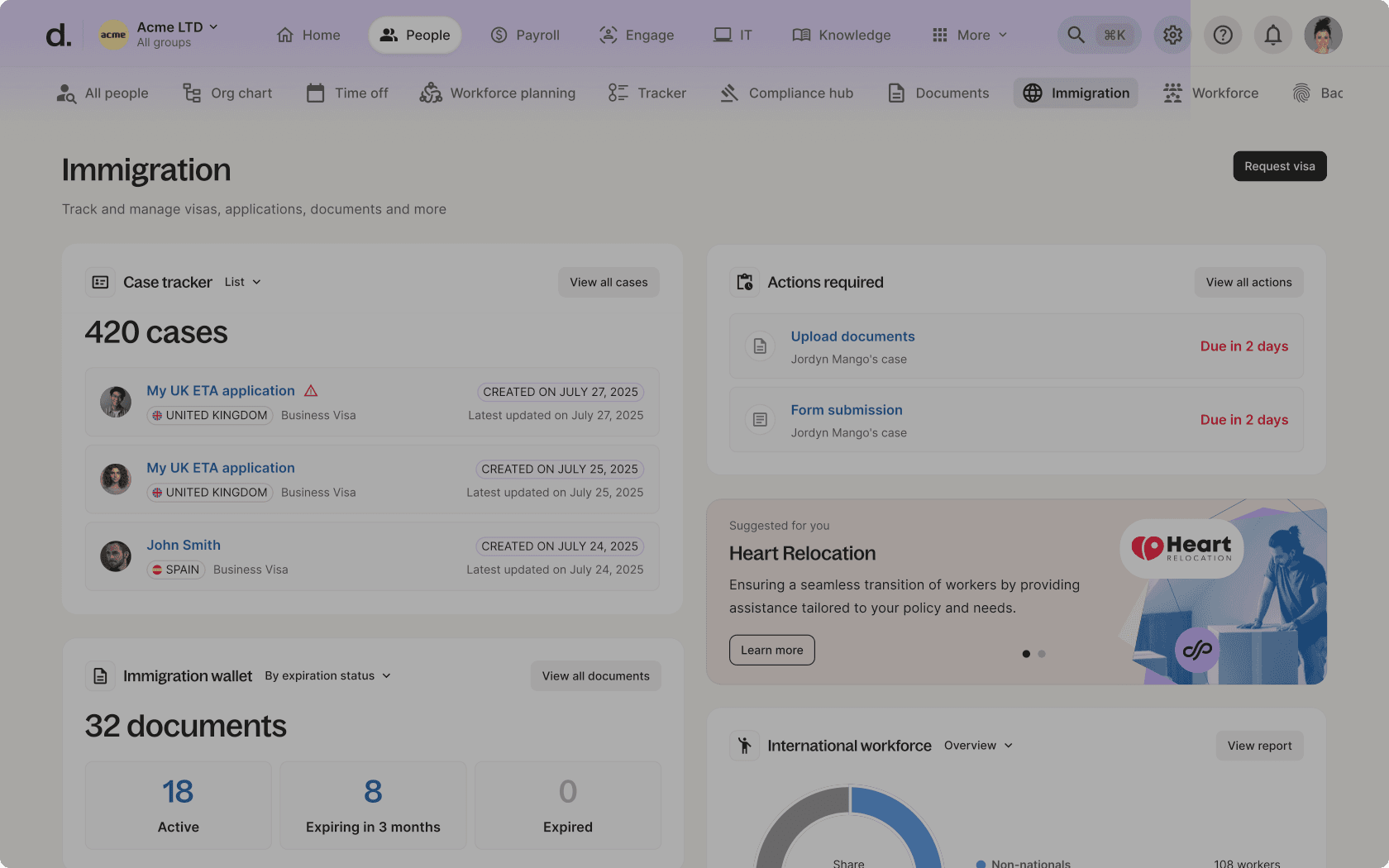Article
15 min read
Business Travel Visas: Guide to Fast, Compliant Employee Travel
Immigration

Author
Angeles Varas Schaer
Last Update
September 06, 2025

Table of Contents
What is a business travel visa?
What types of business travel visas are available?
How to apply for a business travel visa
How to simplify business travel visa applications through Deel
What are the compliance risks of business travel visas?
How long does it take to process business travel visas?
Key takeaways
- Business travel visas come in three main types: ETAs, e-visas, and consular visas. Choosing the right option depends on your destination, trip length, and visa purpose.
- Business travel visas require careful planning and support from tax and immigration experts to avoid compliance risks. These risks could lead to tax exposure, immigration violations, and permanent establishment issues.
- Deel Immigration simplifies business travel visa management by combining expert immigration support with a centralized AI-powered platform. It also offers advanced solutions like EOR visa sponsorship and local entity setup to speed approvals, reduce administrative work, and ensure compliance.
Business travel isn’t always planned; it’s often reactive. A last-minute client meeting. An urgent project kickoff. A high-stakes negotiation that can’t happen online.
Suddenly, you’re racing to secure the right visa with little room for error.
Every destination has its own visa categories and compliance rules. Simple mistakes, like overlooking local restrictions, can turn a short business trip into an immigration violation, unexpected tax exposure, or even permanent establishment risk.
Deel Immigration helps companies avoid these risks. With a 98%+ approval rate, our in-house immigration experts have supported hundreds of employers in securing the right business travel visas quickly and compliantly.
You get a dedicated case manager and full visibility into the process. If your case requires a local sponsor, we provide EOR visa sponsorship through our own legal entities in-country.
In this guide, we’ll break down the essentials of business travel visas. We’ll address the risks you need to be aware of, and how to overcome them with the right strategy and support.
See also: Centralized Global Mobility Management for Large Organizations
What is a business travel visa?
A business travel visa is a non-immigrant temporary permit that allows an individual to enter a foreign country for specific work-related activities, such as:
- Attending meetings or consultations
- Participating in business conventions or conferences
- Negotiating contracts
However, it does not allow the individual to engage in local employment or earn income from local sources.
The definition of business travel and visa requirements vary by country. For example, some countries may require a local sponsor or a letter of invitation from the host business.
It’s important to confirm the specific requirements with the destination country’s embassy or consulate to avoid delays or non-compliance.
With Deel Immigration, an eligibility check is the first step in our Immigration service. Our team of immigration experts and attorneys reviews your employee’s travel plans to determine whether the trip qualifies as business travel under local regulations.
Deel's immigration experts guide us through critical decisions, especially in complex countries like the United States, always ensuring legal compliance in each applicable state.
—David Holguín,
Benefits & Mobility Manager at FEMSA
You can also use our eligibility checker to see if your employee qualifies for a business travel visa. It provides results within 48 hours, including available visa options, estimated costs, and expected processing timelines.
See also: Slash Your Burn Rate with a Global Mobility Strategy
Deel Immigration
What types of business travel visas are available?
Business travel visas fall into three broad categories, each differing in requirements, processing timelines, and average validity.
Electronic Travel Authorization (ETA)
An ETA is a digital entry requirement for nationals of visa-exempt countries. It is linked electronically to the traveler’s passport and allows multiple entries over a set validity period. However, each individual stay is limited to a fixed number of days, depending on the country.
For example, the United Kingdom’s ETA permits up to six months per visit. It is valid for two years or until the passport expires, whichever comes first. Australia’s ETA allows visits of up to three months per stay and is valid for 12 months or until the passport expires.
ETAs are processed through automated systems. Approval can take as little as one hour. This makes them well-suited for short-notice or last-minute business trips.
Legally, ETAs are not visas. If denied, the employee can still apply for a standard visa.
E-Visa
An e-visa is an electronic visa that travelers apply for online. It’s a digitized process that streamlines the visa application and reduces manual work. This creates a shorter process with less paperwork. However, immigration officials still assess the application manually, and it can take several days.
E-visas have a short validity period. For example, Vietnam’s e-visa is valid for 90 days. Russia’s unified e-visa is valid for 60 days from the date of issue and allows a maximum stay of only 16 days.
Consular visa
A consular visa is a traditional visa obtained through a country’s consulate or embassy.
Applicants often need to schedule an appointment, complete detailed forms, provide supporting documents, and attend an in-person interview.
Some consulates allow submission through authorized third parties or by mail. But others, such as US embassies processing B-1 business visas to enter the United States, require the applicant to appear in person.
Due to the formal review and interview process, consular visas take longer to process than ETAs or e-visas. However, they often offer longer validity and greater entry flexibility.
For example, business travelers from the US or Canada applying for China’s M visa may receive consular visas valid for up to 10 years, with multiple entries allowed.
Deel helps me get things done quicker, easier and more cost effectively. We can offer unparalleled worker mobility and flexibility which our team values,
—Emma Leipold,
Senior Global Mobility and Total Rewards Partner at ZipCo
See also: How to Get the Best Global Talent for Your Startup With EOR Visa Sponsorship
How to apply for a business travel visa
The business travel visa application process generally includes the following steps, though requirements can change depending on the destination:
1. Check eligibility and visa requirements for the destination country. Visa rules vary based on the traveler’s nationality, permanent residency status, purpose of visit, and duration of stay.
2. Gather required documents. Commonly requested documents include:
- Valid passport
- Completed visa application form
- Passport-size photographs
- Invitation letter from the host company detailing the business purpose
- Travel itinerary, including flight and accommodation details
- Proof of employment or company affiliation
- Proof of sufficient funds
- Business registration documents of the inviting company
3. Submit the visa application to the appropriate consulate, embassy, or online portal.
4. Pay the applicable visa fees.
5. Wait for visa processing. Processing times vary by visa type and country of application.
6. Receive your visa. This may be issued as:
- A physical visa sticker in your passport (for consular visas)
- A digital visa received by email (for e-visas)
- An electronic authorization linked to your passport (for ETAs)
See also: Best Global Mobility Software 2025: 8 Must-Have Features
How to simplify business travel visa applications through Deel
Deel offers two main pathways to help companies manage business travel visas more efficiently:
Option 1: Deel-sponsored business travel visas
In some countries, business travel visas require sponsorship from a locally registered entity. If your company lacks a local presence or the necessary sponsorship license, Deel can sponsor the visa through its Employer of Record (EOR) infrastructure that covers 150+ countries.
When you combine our EOR and immigration services, Deel:
- Becomes the legal employer of the traveler during their stay
- Provides the required sponsorship documents, such as invitation letters or employer support letters
- Ensures compliance with local immigration laws
- Assumes responsibility before immigration authorities throughout the process
Your company retains full visibility through Deel’s dashboard. You can track the visa application status in real time, review next steps, get expected timelines, and see what actions you or the employee need to take.
Option 2: Direct sponsorship visa support
If your company already has a local legal entity and can sponsor employees’ visas internally, Deel Immigration can support your in-house application process through its standalone immigration and visa services.
With this option, Deel Immigration provides:
- A dedicated case manager and in-house immigration legal support
- Step-by-step guidance through the visa application process
- Document preparation and legal review
- Support for renewals of business visas and related permits
You also gain access to Deel’s centralized immigration dashboard. It offers:
- A self-serve document upload system for employees
- A complete view of all pending and active visa applications, including work visas
- Alerts for upcoming visa expirations
- Option to book time with your dedicated case manager through the dashboard when you need hands-on support during the visa process
See also: How HR Can Streamline Visas & Immigration for Global Talent
Discover how TalentQL simplifies visa and immigration processes with Deel. By leaving visa processing to Deel, the team can focus on more value-driven tasks.
Because Deel makes the immigration process extremely straightforward, myself and the rest of the TalentQL team are able to focus on the core aspects of our operations, without expending too much time or resources. You simply upload everything to the dashboard, and Deel’s team takes it from there.
Having a partner like Deel makes corporate immigration and global expansion much easier. Deel helps us get results without any stress.
—Adewale Yusuf,
Co-founder, TalentQL and CEO of AltSchool Africa
License Application Support
What are the compliance risks of business travel visas?
Business travel visas have strict limitations. Even short visits can carry significant compliance risks if the traveler engages in activities that go beyond what’s permitted.
Here are key areas to monitor when sending employees abroad on business visas.
Unauthorized activities
A common compliance risk is engaging in work that exceeds the scope of a business visa. These visas allow only passive business functions, such as attending meetings, conferences, or brief training sessions.
Visa holders should not:
- Perform any hands-on or productive work, even if unpaid
- Receive income from a local source or engage in activities that resemble local employment
- Work from the company’s local office, client sites, or project locations
- Manage or supervise local staff in a way that creates employer-employee obligations under local labor laws
- Engage in activities that lead to local business operations, such as setting up a branch, negotiating leases, or overseeing hiring
- Use the business visa to perform operational tasks outside of meetings, negotiations, or training sessions
Crossing these lines can result in immigration violations, fines, or future visa denials.
How to address this risk:
Ensure every trip is backed by a clear travel purpose that aligns with what the business visa legally permits. Educate your employees on what they can and cannot do while abroad, and review itineraries before travel to catch any red flags.
If planned activities fall outside legal limits, apply for the appropriate work authorization instead.
Tax implications
Many travel managers and companies underestimate the tax risks tied to short-term business travel. Depending on the country, obligations may arise due to:
- Number of days physically present
- Type of work performed
- Economic or habitual ties formed during the visit
If the employee meets the thresholds, they may become a tax resident in the host country, leading to income tax filings, social security contributions, and employer reporting obligations.
In Canada, a person may become a deemed tax resident after spending 183 days or more in the country in a calendar year. However, this does not apply if they are a resident of another country under a tax treaty with Canada.
In Australia, a person can become a tax resident even without reaching 183 days, under the “the resides test.”
This test considers factors like the person’s behavior, intentions, and integration into Australian life. Tax authorities may treat your employee as a tax resident if they adopt a settled routine similar to their normal lifestyle.
How to address this risk:
Consult a local tax advisor before approving international business travel, especially for extended stays or revenue-related work. This ensures you understand potential tax exposure for both the company and employee and can take the necessary steps to avoid unexpected tax liabilities.
Permanent establishment (PE) risk
Regular or high-value business travel can trigger permanent establishment risk. If authorities determine that your business has a consistent and ongoing presence in the country, they may treat it as a taxable local entity.
Failure to report presence or activity can result in corporate tax obligations, local registration requirements, or financial penalties.
Your employee could create PE risk if they:
- Habitually negotiate or finalize contracts on behalf of the company
- Conduct sales meetings that directly lead to revenue
- Perform core business functions tied to the company’s income
- Visit frequently or stay long enough to resemble an ongoing local operation
How to address this risk:
Limit the scope and frequency of international travel for roles involving client-facing, revenue-generating, or strategic activities. Avoid assigning tasks that resemble long-term presence as well.
In the case of ongoing local work, consider moving to a compliant work visa under a proper employment structure. Options include:
- Deel Employer of Record service: Deel becomes the legal employer and sponsors the employee’s work visa through one of its local entities. We handle local payroll, tax compliance, and immigration filings on your behalf
- Entity setup: If you’re planning long-term operations, Deel can help you set up a local entity. We manage the incorporation process and ensure full compliance with local tax, payroll, and registration requirements
See also: How to Compliantly Send Employees Abroad to Test Markets
Effortless Visa Sponsorship
Don’t meet the requirements to sponsor workers’ visas?

A1 certificate requirements
An A1 certificate may be required for employees traveling within the European Union (EU), European Economic Area (EEA), or Switzerland. This document confirms which country’s social security system applies during the assignment and prevents double contributions.
As the employer, you are responsible for applying for the certificate on behalf of your traveling employee. The employee should carry it during the trip.
The certificate covers assignments up to 24 months. If the employee’s stay extends beyond this, they may need to apply for an extension or switch to the host country’s social security system.
Failure to secure an A1 certificate when required can result in penalties and unexpected social security liabilities.
How to address this risk:
Leverage Deel Immigration. Based on the trip’s details, our immigration team will evaluate whether an A1 certificate is necessary. We’ll assist with the application process and ensure accurate documentation.
You’ll also receive automated alerts on your Deel dashboard when a certificate is approaching expiration, with renewal support included.
Discover how Taktile used Deel to process 3+ visas hands-free, compliantly, and through a user-friendly platform.
We leave everything in Deel's hands ... but it is good to have transparency and a lot of visibility as to how the case is developing.
You don’t need to dig too much to understand how [Deel] works—with its quick 5-minute profile setup and other quick, easy-to-use features.
—Valeria Rosati,
HR Operations Lead at Taktile
See also: International Business Travel Insurance for Global Teams
How long does it take to process business travel visas?
Processing times for business travel visas vary widely depending on the destination country, visa type, and the applicant’s nationality.
ETA visas have the shortest processing times, followed by e-visas. Consular visas take the longest.
Electronic Travel Authorization
Average processing time: 72 hours
Examples:
- United States (ESTA): 72 hours
- Israel (ETA-IL): 72 hours
- Australia (ETA 601): 72 hours
E-visas
Average processing time: 1 to 4 weeks
Examples:
- Thailand (Non-Immigration B Visa): 2 to 4 weeks
- UAE (Visit Visa): 3 to 30 days
- Kenya (E-visa): 4 weeks
Consular visas
Average processing time: 2 to 6 weeks
Examples:
- Germany (Schengen C Visa): 2 to 6 weeks
- China (M Visa): 4 weeks
- Hungary (Schengen Visa): 4 to 8 weeks
See also: US Visa Denials, Refusals, Rejections, and Other Roadblocks
Fast-track your business visa application process with Deel Immigration
Deel combines expert human support with an AI-powered platform to simplify and speed up every step of your business visa process.
Our immigration specialists assess each trip, confirm eligibility, and guide you through the right visa path. You get a dedicated case manager, real-time tracking, automated alerts, and centralized documentation for all your company’s visas, including work visas.
If you need a local sponsor, Deel can provide EOR visa sponsorship through our owned entities in 150+ countries. Already have your own entity? We’ll support your internal process with end-to-end guidance and access to local immigration attorneys.
Ready to simplify talent mobility for your organization?
More resources
FAQs
Do business visa applications require legalizations, apostilles, and translations of documents?
It depends on the destination country’s requirements. Some consulates may request legalized or apostilled documents, especially for long-term visas or corporate documents. Translations may also be necessary if the documents are not in the destination country’s official language.
However, for most short-term visits, such as attending meetings or conferences, many countries only require basic documents like a passport and an invitation letter, without the need for legalization.
Deel’s immigration experts confirm documentation requirements directly with the relevant embassy or consulate before your application begins to ensure full compliance.
Do employees have to apply for a visa when going on business travel?
In most cases, yes. Employees usually need a business visa to travel internationally for work-related activities. However, if the destination country offers a visa waiver program, eligible travelers do not need a visa and can instead enter with an Electronic Travel Authorization.
What types of work-related activities fall under a business travel visa?
Business travel visas allow short-term, non-technical business activities such as:
- Attending meetings or negotiations
- Participating in conferences, seminars, conventions, or trade shows
- Receiving short-term training
- Visiting clients’ offices without delivering services or performing hands-on work
- Observing business operations when the activity is strictly observational
- Conducting market research
How does a business travel visa differ from other work visas?
Business travel visas:
- Permit short-term, non-productive activities such as meetings or training
- The traveler is paid by the home country employer or may be unpaid
- Does not provide legal authorization to work or earn income in the host country
- Allow hands-on work, local employment, or long-term assignments
- Employee is paid by a local employer
- Provide legal authorization to work and receive income locally
Can an employee switch from a business visa to a work visa?
In some cases, yes. But it depends on the destination country’s immigration rules. Certain countries allow a change of status from business to work visa while the employee is in-country. Others require the employee to return to their home country to apply.
To switch to a work visa, the employee should:
- Meet the host country’s eligibility requirements
- Have a valid job offer from a local employer
- Obtain employer sponsorship or an approved petition
- Submit required documents and pay application fees
- Comply with local procedures and timelines
What is the difference between a business visa and a tourist visa?
A business visa allows entry into a country for short-term and passive work-related activities such as meetings, conferences, or training.
A tourist visa is intended for personal travel, such as vacations, sightseeing, or visiting friends and family. You cannot use it for business purposes.
Using the correct visa type helps avoid entry denials, fines, or legal complications.

Angeles Varas Schäer is a global mobility specialist with a background in international law and years of experience helping professionals and companies navigate complex immigration processes.














